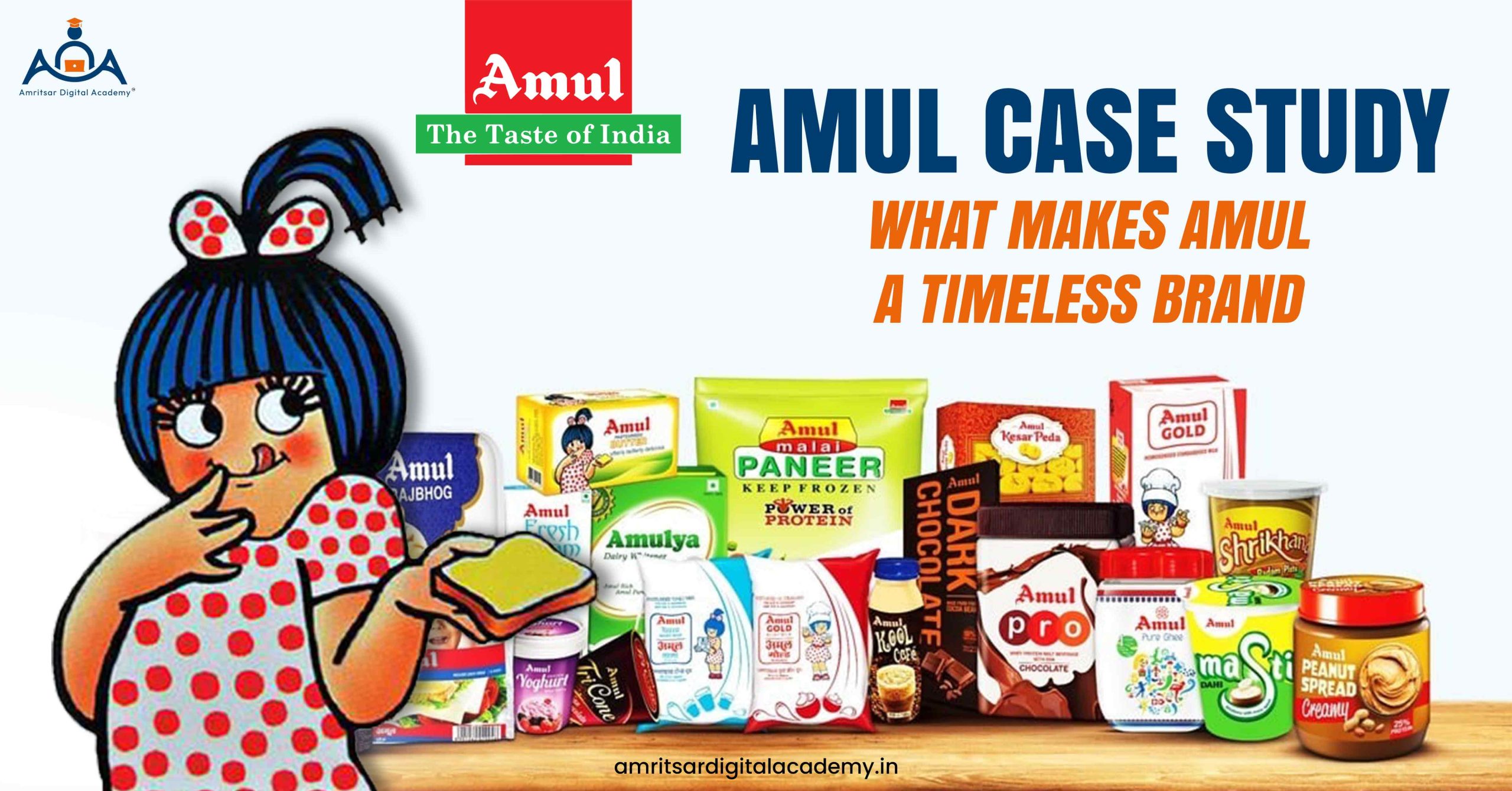“Amul The Taste of India”
“Amul Doodh Peeta Hai India”
“Utterly Butterly Delicious”
These are not just slogans.
They are part of how we grew up.
Imagine you are having hot paratha on winter morning and you reach out for that familiar yellow and blue packet of butter. That moment of comfort is brought to you by Amul. It has become a part of everyday lives of millions of Indians. But how did cooperative dairy brand turn into cultural icon?
As you read this Amul case study you will learn about their business model, target audience, strategic marketing campaigns and Amul branding strategies.

Table of Contents
- The Birth and Success Story of Amul
- Business Model of Amul
- Amul Target Audience
- Amul’s Marketing Campaigns and Strategy
- Digital Marketing Strategies of Amul
- Most Popular Marketing Campaigns of Amul
- Amul’s Product Portfolio and Expansion Strategy
- What Makes Amul a Timeless Brand?
The Birth and Success Story of Amul
The story of Amul begins in 1946 in small town of Gujrat called Anand. Back then, the dairy sector was dominated by middlemen who paid low prices to farmers and sold at very high margin to consumers. Farmers came together and started cooperative to fight this situation. Then Dr. Verghese Kurien who is the father of the White Revolution joined this movement to stop this exploitation. He bring new ideas, innovative technology and builds trust with farmers. Amul started because people wanted fairness. Over time it became sign of change and hope for farmers.
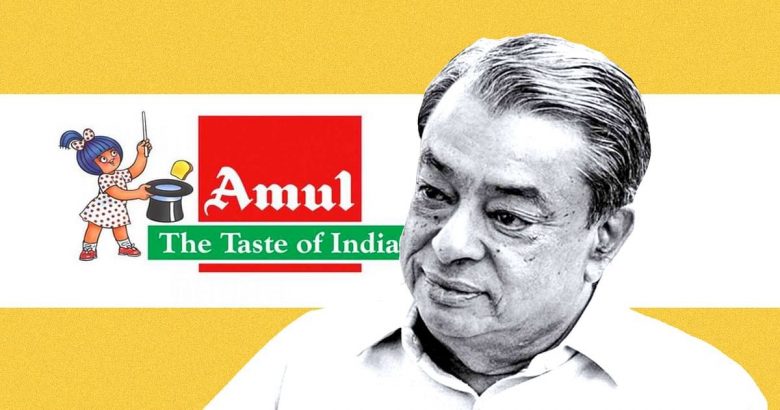
The name ‘Amul’ itself derives from the Sanskrit word ‘Amulya’ which means priceless and reflects the founders to belief in the invaluable contribution of dairy farmers to the nation’s economy. The success story of Amul is not just about corporate achievement it’s about socio-economic movement. By eliminating middlemen and connecting producers directly to the market Amul became spark in transforming India from milk deficient country to the world’s largest milk producer.
Amul was more than just a brand—it was a movement that combined innovation, rural empowerment, and scale. No wonder it has remained key pillar of the Indian dairy industry for over seven decades.
Business Model of Amul
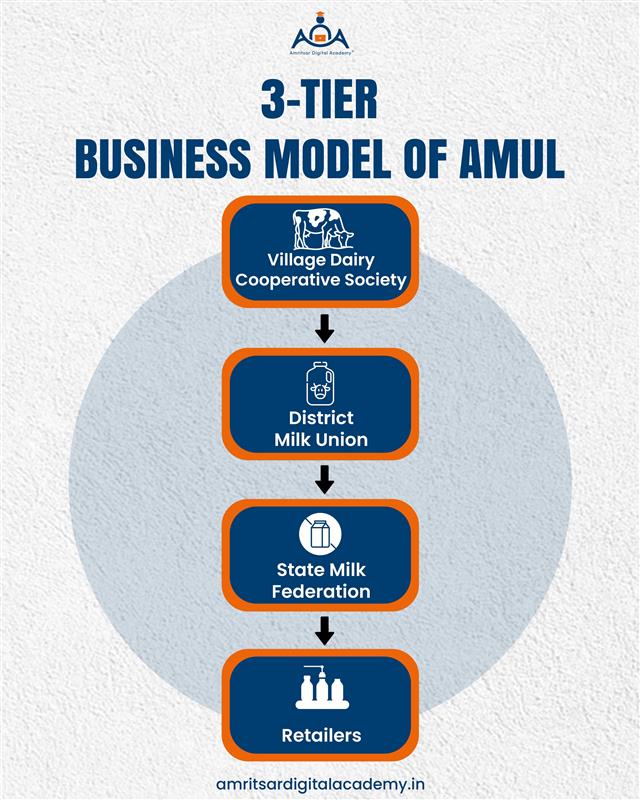
Amul follows three tier business model to provide milk to their customers. The first tier is village dairy cooperative society, next is the district milk unions & then thrid is the state milk federation. Let’s briefly understand the business model of Amul in this Amul case study:
- Village Dairy Cooperative Society: This is first tier of business model of Amul in which local dairy farmers come and combine their milk. After that, depending upon quality of milk its segregated and supplied to second tier.
- District Milk Unions: At this stage milk is taken to the district milk union centers where it’s processed and packed. Before that it goes through quality check to make sure it’s safe and good enough for the market. Based on factors like fat content, water level, and nutritional value the milk is then graded accordingly.
- State Milk Federation: In this final stage of milk production packaged milk arrives here and is sent out to suppliers and then deliver it to local retailers. It’s also the stage where other dairy products like curd, butter, and cheese are made. Once everything is ready, the finished products are sent to the market.
Amul Target Audience
The Amul provides dairy products at very reasonable prices. Amul divides its target audience into two market segments. Here are two main types of customers:
| Target Audiece of Amul | Target Audience of Amul |
| 1. Business to Consumers (B2C) (These are those consumers who buy Amul products for their daily personal use) | For Kids-Amul Milk, Amul Chocolates, Amul Kool, Nutramul For Young people-Amul Pizza, Cheese Spread, Pizza Cheese For Health conscious people-Amul Lite Butter, Nutramul, Amul Shakti, Sugar-Free or Skimmed Milk Powder |
| 2. Business to Business (B2B) (These are businesses that buy Amul products in large quantities) | Milk: Sold to restaurants, ice cream makers, tea/coffee cafes, and local food stalls Butter, Ghee, Cheese, Paneer: Sold to bakeries, food stalls, and restaurants |
Amul’s Marketing Campaigns and Strategy
One cannot discuss the Amul Case Study without highlighting its iconic marketing strategies. The marketing campaigns of Amul, especially the ‘Amul Girl’ ads, are legendary. Its digital marketing strategies include social media engagement, YouTube recipe channels, and interactive posts that keep consumers engaged while subtly promoting products. The seamless transition from traditional to Amul digital marketing shows the brand’s adaptability and keen understanding of consumer behavior. Some of hit digital campaigns covered in this Amul case study include:
Most Iconic “The Amul Girl” Ad

Amul butter girl first ever ad copy was released in 1967. Amul case study is incomplete without mentioning this Amul girl. This is longest run ad campaign that has ever happened on planet earth. Amul has used witty, satirical billboard ads featuring the butter girl to comment on current events. This made the brand not just relatable but culturally relevant.
Also read: Nestle Marketing Strategies: Case Study
Digital Marketing Strategies of Amul
In this digitalized world every brand needs strong digital marketing strategies. Amul has also reduced its spending on TV ads and shifted its focus toward online advertising like its competitors.
Social Media Marketing Strategies of Amul
Social media platforms have become crucial channels for Amul to maintain relevance with younger demographics while preserving the brand’s distinctive voice. Amul digital marketing approaches include targeted campaigns on platforms like Facebook, Instagram, and YouTube, where the brand shares everything from recipes and health tips to behind-the-scenes content about cooperative operations.
- Amul on Facebook has 2M followers.
- Amul on YouTube has 521K subscribers.
- Amul on Instagram has 499K followers.
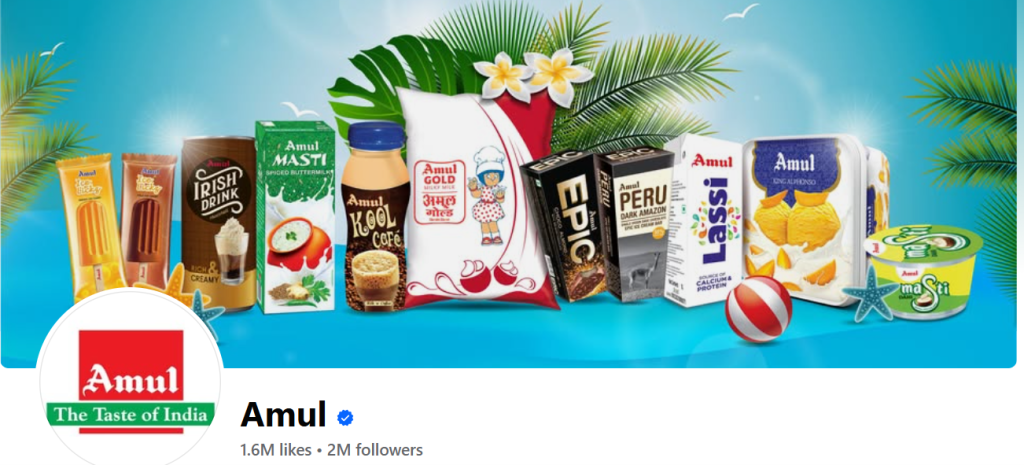
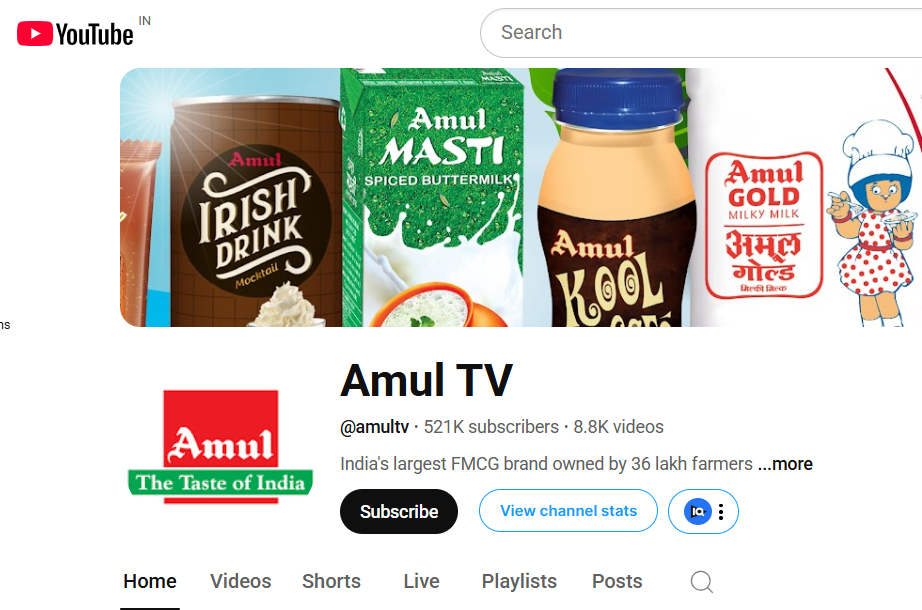
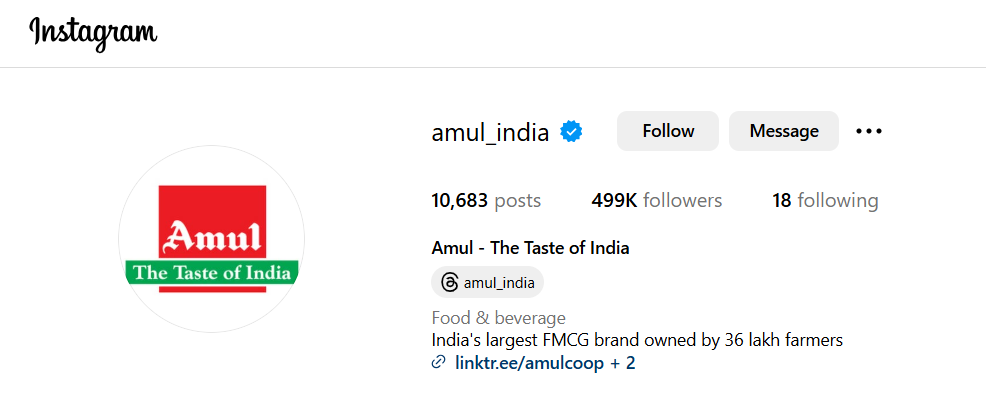
Most Popular Marketing Campaigns of Amul
From day one Amul has created content for newspapers and banners which makes it easy for Amul to shift from offline marketing to online digital marketing. Their most loved posts on Facebook and Instagram often feature the iconic Amul Butter Girl, paired with clever takes on trending events from around the world.
Here are some of Amul’s digital marketing campaigns which were a hit on Facebook as well as Instagram.
“Eat Milk with Every Meal”


Amul hired digital marketing agency called Draftfcb Ulka in 2013. The objective of this marketing campaign of Amul is-
- To educate Indian buyers about the goodness of milk and its byproducts.
- Trying to give milk and their whole range of dairy items fresh and modern image that attracts people of all ages.
National Milk Day Campaign

In this marketing campaign of Amul, they organised bike rally for 50 bikers who travelled from Varanasi to Anand to meet dairy farmers, dairy professionals and to learn about Dr Kurien and his works. They used hashtag strategies like #26 November, #CelebratingDrKurien, #BikeRally, #VaranasitoAnand to connect with young audience to inspire them in their lives.
Amul Ice Cream – Real Milk, Real Ice Cream

This campaign by Amul is strategic move to build strong brand identity in crowded dessert market. This campaign gives powerful message to their audience that Amul ice cream is made with real milk and pure ingredients.
Amul Butter – Taste of India
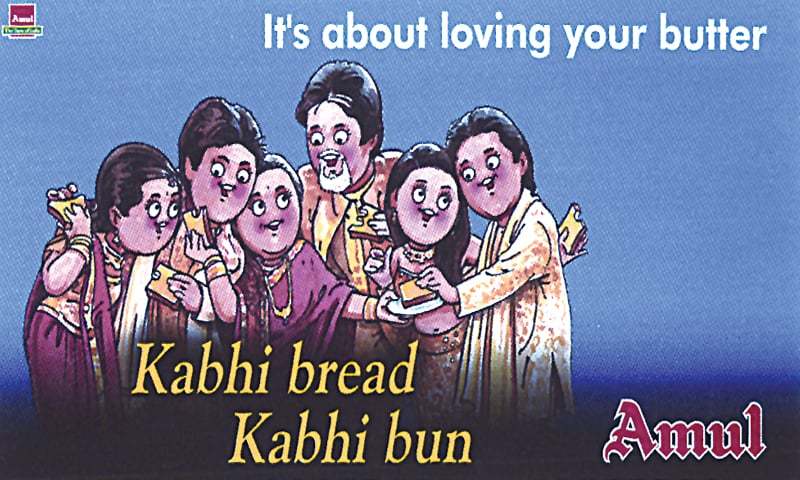
Amul Butter–The Taste of India campaign is one of the most iconic marketing campaign of Amul.
- The Amul butter girl is face of this campaign.
- This campaign has run for decades with the same mascot and tone.
- “Utterly Butterly Delicious” is instantly recognizable and emotionally resonant of this campaign.
Amul’s COVID-19 Campaigns (2020)

“Stay Home, Stay Safe, and Have Amul”
This campaign run by Amul during COVID-19 pandemic. The campaign also supported the idea of home cooked meals and positioning Amul as trusted kitchen companion.
Amul’s Product Portfolio and Expansion Strategy

- Amul started as simple milk brand but today its product portfolio includes over 50 value added dairy products.
- From core dairy products like milk, curd, butter, and cheese to diversified segments like chocolates and frozen foods.
- Amul continually expands its offerings while staying true to its core value of affordability.
- Amul also invests heavily in research and development to innovate new products such as lactose free milk and immunity boosting beverages.
What Makes Amul a Timeless Brand?
- Constant Innovation: From starting with just one single product milk to 2000+ products, Amul has become industry giant in Indian dairy industry.
- Diversification: Amul recognises daily needs of their target audience. Brand analysis and got something for everyone. Because of their variety and strong efforts its hard for any new company to compete with them.
- Trust Building: One of the main key factors of success of Amul is its credibility towards its consumers. By providing fair prices and pure quality product it becomes No. 1 brand in Indian dairy industry.
- Amul Girl: The main face of Amul is its ‘Amul Girl’ who connects emotionally with the target audience of Amul. Brand strategically used ‘Amul Girl’ to advertise their brand and engage with audience.
- Decoding Whole Supply Chain: One of the main and biggest reasons for Amul’s success was that they managed the whole supply chain of milk production so efficiently. With its three tier business model of Amul they properly managed and provided high quality to their consumers at fair prices.
Wrapping Up…
The Amul case study proves that cooperative model can revolutionize an entire sector. With strong Amul business model, iconic branding like Amul Girl and smart Amul marketing strategies, the brand became household name. From empowering farmers to dominating the Indian dairy industry Amul has stayed true to its roots. Its affordable pricing, innovative campaigns, and vast product range keep it ahead of competitors. The Amul brand is not just about dairy—its about trust, quality, and emotion. Be it butter on hot parathas or milk in your tea Amul remains “The Taste of India.”

